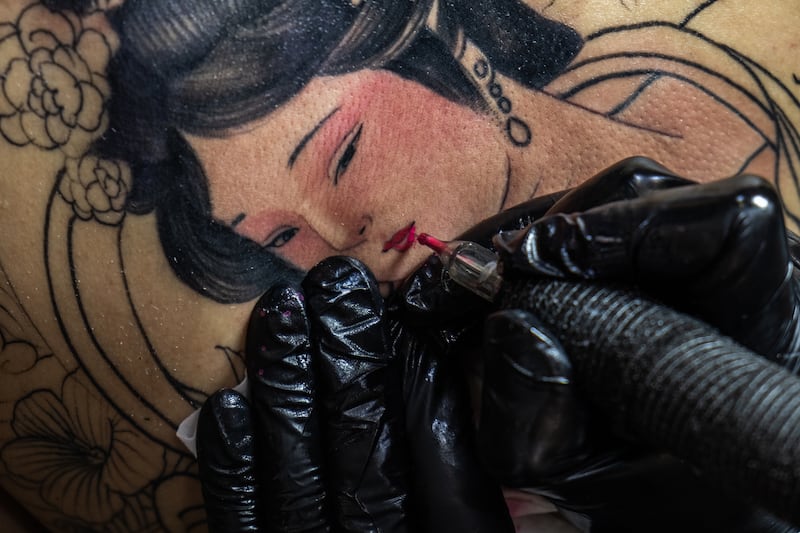The new tattoo may be of an unfurling script, a bold geometric sleeve or a funny illustration. Perhaps it is your first or joins a medley: inked in honour of a person, place or the spirit of self-expression.
Getting a tattoo is less fringe than it once was, but while they are more widely accepted, advice on caring for them can be conflicting.
The confusion begins as soon as the artist puts down the machine. Some use a classic plastic wrap as a cover to protect your brand-new ink, while others opt for newer dressings. One recommendation is to wash tattoos immediately after returning home, using an antibacterial soap. Another is to wait a few days before washing with a milder, fragrance-free soap.
Then there are the ointment options: recommendations include options from Vaseline and Aquaphor, natural oils and butters, and nappy rash creams to a market of products geared specifically toward tattoo healing.
‘I found out the rugby player I’m seeing is four-timing me, and I am more attracted to him than ever’
‘I couldn’t sit through it’: New Oscars rule requires members to watch all films before voting
At home with Brendan Courtney by the sea in Wicklow: ‘I wanted to simplify my life’
Wealth gap tensions: ‘My friends don’t have to budget like me. A round of cocktails scares the s**t out of me’
It can all be bewildering.
[ The growing popularity of tattoos - ‘It’s much more accepted now’Opens in new window ]
“There seems to be a lot of misinformation out there,” said Naresh Bhana, owner of Flamin’ Eight, a tattoo shop in London. “We owe it to our clients to help them through that process as best we can.”
Your health history, the size of your new tattoo and where it is on your body can all affect healing, according to artists and dermatologists.
But everyone agrees that it’s important to keep the area clean, especially early in the healing process, which can take two to four weeks.

When a tattoo is made, needles drive ink particles through the skin’s top layer and into the dermis below, leaving little open wounds that can act as “microchannels,” said Deborah S Sarnoff, a clinical professor of dermatology at New York University.
“It’s not unusual for those wounds to ooze and ink to come out – and you don’t want bacteria, virus or fungus going in,” she said, adding that for around 48 hours, the wound is especially vulnerable to infections. That means no swimming in the ocean, hot tubs, pools or anywhere that could introduce pathogens. (Perhaps rethink that tattoo right before, or during, your vacation to the beach.)
Some artists recommend washing a new tattoo a few hours after your appointment, to clear it of any ink and plasma build-up. But Sarnoff advises leaving a dressing on and not washing the tattoo for about two days. After that, she says, wash your own hands first before cleansing the area around twice daily.
“You want it to be a very gentle soap – preferably unscented, preferably fragrance-free,” she said.
“No scrubbing, no picking of scabs, no pulling them off,” said Bruce Robinson, a board-certified dermatologist in New York City. “Gently soaking. Whatever comes off comes off with just regular soap and water.”
But even the choice of soap can be polarising. Some tattoo artists recommend antibacterial soap to prevent infection. Others, like Bhana, say those are too harsh: “You really want to use something that is absolutely mild and pH neutral as absolutely possible.”
Keeping a wound moist gives it the best chance of healing well and without scarring, according to dermatologists. But unless it’s infected, they advise skipping the antibiotic creams and specialised products in favour of a classic: petrolatum, or petroleum jelly, which is commonly sold as Vaseline.
“Vaseline is better than pretty much anything else because there’s nothing in it that would cause a reaction,” said Robinson, adding that scents and other ingredients like preservatives could cause an allergic reaction.
Tattoo artists will often send their clients home with petrolatum-based products like Aquaphor or A+D ointment and tell them to switch to a lighter lotion after several days. But unlike dermatologists, many of the artists say that personal experience has taught them a tattoo needs air to heal and caution against petrolatum-based products.
Since Lal Hardy opened his London studio over 40 years ago, products for tattoo aftercare have multiplied, he said. Hardy often recommends cocoa butter or an unscented, hypoallergenic moisturiser easily found in drugstores. “They just seem simple to use for people, which is what you want,” he said.
Hardy recommends a thin layer of cream in between washes but warns against overdoing it, adding that tattoos need air to heal. “If people keep putting cream over cream, the air never gets to the tattoo,” he said.
Dermatologists say there is no solid evidence that points to any product over Vaseline. “Maybe they want to sell you their own products,” Sarnoff said of tattoo artists, though she noted that tattooists had the most first-hand experience of the healing process.
“If they think petrolatum is a no-no, then you’ve got to choose something else, some kind of an oil,” she said. “But you’ve got to keep it moist.”

It may take several weeks or longer, depending on the size of the tattoo, but once the skin is smooth, your tattoo is healed. Using sunscreen on the fresh tattoo can keep it looking crisp for longer.
Dermatologists say that patients who consult them after getting a tattoo commonly do so because they develop an allergy to the ink, experience raised scarring or simply regret their choice. If the healing process begins to lag, Sarnoff said, seek a board-certified dermatologist for an opinion.
“It’s not like a haircut,” she said, likening the process to a medical procedure and cautioning people to do their research. “They need to be aware of the downsides and what could go wrong.”
Many artists said that with proper application and aftercare, tattoos should heal without any issue. If problems emerge, most advise returning first to your artist to discuss next steps.
Whatever ointment, soap or dressing you choose, there is no shortcut to healing. “You cannot make it heal quicker than the body will naturally heal it,” Hardy said. “Let your body do the work, and it will be fine.” – This article originally appeared in The New York Times.
2024 The New York Times Company










